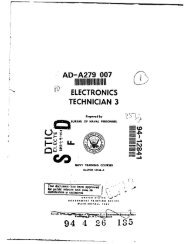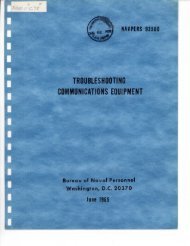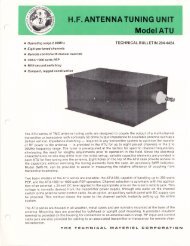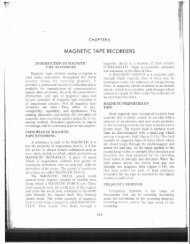L - VIR History
L - VIR History
L - VIR History
You also want an ePaper? Increase the reach of your titles
YUMPU automatically turns print PDFs into web optimized ePapers that Google loves.
ELECTRONIC CIRCUITS NAVSHIPS<br />
microwave siqnal with thelocal oscillator siqnoi to prod~ce<br />
the desired intermediate frequenq (i-f) output siqcd. Tne<br />
microwave diode mixer 1s senerally used :n app!lcotions<br />
where signal-tmaise rotio 1s M importmt canslderation or<br />
where trmsit umeot very hiqh frequencies becomes critical<br />
for other types of semicon'.. ~~ctoi mixers.<br />
cHrarClEa!sT!cs.<br />
1-f voltage is l~neorly dependent uwn sianal omalitude,<br />
for signaissmoli compared wlti the local osciiiator power.<br />
Transit timeeffects are minimized.<br />
Overaii noise fiqurels cs lo^,# as 7db it frequencles IF.<br />
to 25,000 MHz.<br />
Requires c separate locai osciliutai !a ssp21y the<br />
*-*.-.-A,..:-. ..-I<br />
" L,LL.. "l.' ,I.,,,<br />
Output clrcultist~ned to the 1-f frequency.<br />
Converslrn qaln 1s less fhon unlty.<br />
CIRCUIT ANALYSIS.<br />
General. T?e crys:a! 1s the rast e!iect?ve tlexmt for<br />
the superheterodyne recelver ot microwave frequencles.<br />
The operollon l f o ciystai cs a mxer is similar !a that of<br />
the diode electror tube. Slnce a clystai is not or wnplifier,<br />
there con be no conversion gain. The conversion loss is<br />
token as the :atlo of the available i-f sincd power to the<br />
availot!e r.f -;- -A,~U. -\ - pcr.e,. . . . T. . ~ ~.;es ijlth tL,e circiit impedance<br />
but is normally about 6 to 10 db. Crystals are<br />
easily damaged, and voltages should not be mpplied which<br />
are greater thm ohout 5 volts in the blocking (anode to<br />
cathode! ?!rec!?cz or which ies~!! i: more tho- ate-t 1-v?c<br />
m a resistive ioas. in uppilcotion, the ces.:d 1-1 lnput<br />
signd MC 1b.e iocal osc~llctor s~qmal are 3ppi!ed in serles<br />
lo the mlcro*c,~,t. do;?, w,; t!lt -,lie: ~ ~,tj~t volta,~e is<br />
obtained from o trorsfar-er t~~ned to the desired i-f siqmal<br />
so that it 'V~lii pcss tn,; !:eq*er.i, an; :eject ul: itt,e; irequenaes.<br />
Circui! Operatio-. 4 5?-.p!?!led m?crcwcvP dicde m?uer<br />
circuit is snow, ln the accnrnpmyinq illustrction.<br />
AAAA<br />
vvvvl;<br />
INPUT<br />
-<br />
i - -I- -<br />
Microwfive Diode Mixer Equivalent Circuit<br />
I-F<br />
OUTPUT<br />
0967-0040120 FREQUENCY CONVERTERS<br />
Tronsiormer TI consists of m untuned primw windina<br />
and o tuned secandory windlng; Capacitor C1 and the SEondory<br />
winding of T1 form c resonant circuit at the frequency<br />
of !herecelved i-f signal. Transforxer T2 is similar<br />
to TI, except that copilcitor C2 and the semndary windinq<br />
of T2 form a resonant circuit at the frequency of tie local<br />
oscillotor. The resocant circuits, shown in the schematic<br />
os TI, C! ;~d T?, C?, are nc?~~! L C cirmits csxpcscd of<br />
inductors and capacitors a! radio frequencies.<br />
Semiconductor CR1 1s o point contact crystal dike<br />
used ot mlcrowove frequencies. Trmsfom.er T3 is o douYetuned<br />
tronsformer, .>~:h tnep:imov cnd secondarf arc;lts<br />
iemnmt to the intenmehat? frequency. %is trm~sformer<br />
hcs a bandpcss ckm-;ctc:.sac ,XP,I~: c:;c:l-;,lno:es cocinst<br />
:iq"",~ies u3w"c ",I: i;,r :rni,r; uuiput ilniunl~v.<br />
When no r-f siqnd is appllec to *,e input cf transfomer<br />
Ti, but the locd oscllictor s~c-al IS op~iied to the inpct<br />
(primary) of trorsforrner T?, seclcondcctor CP1 cctr ody<br />
as o rec1;iler. For :cis 11:p~t icr.iitix, tSe c~r;ent ~uIsations<br />
pcssinj; L$:c;gh the primary ;uii.dinq of the double<br />
tuned transformer, T3, are those of the local asclllator fie<br />
quenq; however, the tuning of tionsiornei T3 does not<br />
permit the local oscillotor frequency to reach the output<br />
because of the bandpass choiacteristlc of the transiormer.<br />
W.en the :-i ad !occ! osallata: simcls are op;l;el<br />
simuitoneousiy lo their respecuve runed circuits, ine<br />
two s~pal voltages are applied in serles to semiconductor<br />
mixer diode CR1.<br />
Since the two appiled slqnals differ in frequency, the<br />
...I. ""-* "."--. -1 " :- -L--- ... :.L ---: -.L-. n..:.2<br />
"Y'LYYL~ Yli ,,", "I"*YIa .,, p,,">i ""11!1 CYL:? VL::C:. rC::U"-<br />
icoiiy tnese rwo .






